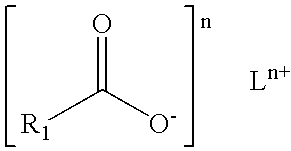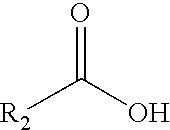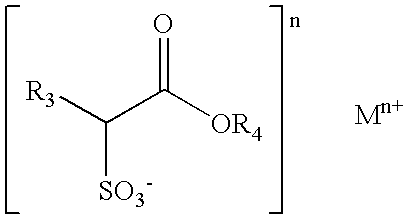Soap Bar Compositions Comprising Alpha Sulfonated Alkyl Ester or Sulfonated Fatty Acid and Synthetic Surfactant and Process for Producing the Same
a technology of alkyl ester or sulfonated fatty acid and composition, which is applied in the direction of detergent composition, detergent compounding agent, and ampholytes/electrolyte-active compounds, etc., can solve the problems of high lathering soap bars that fail in this respect, syndet bars often possess poor physical properties, and exhibit odors, etc., to improve processability, improve foaming properties, and improve the effect of performance and processing synergi
- Summary
- Abstract
- Description
- Claims
- Application Information
AI Technical Summary
Benefits of technology
Problems solved by technology
Method used
Image
Examples
example 1
Procedure for Making Cleaning Bar
[0096] One procedure for making soap / SME and / or SFA combo bars is as follows: [0097] (1) Neat soap is melted in a steam jacketed crutcher (about 140° F. to about 200° F.) [0098] (2) Free alkalinity of neat soap is neutralized to about 0.1% maximum with inorganic acids, such as phosphoric acid, or organic acid such us coco fatty acids, or citric acid. [0099] (3 ) Alpha sulfomethyl ester, alpha sulfonated fatty acid or mixtures thereof, as a dried paste or an aqueous solution, is added to the crutcher with stirring, and agitation is continued for about 5 minutes. [0100] (4 ) Additives, such as stearic acid and / or coco fatty acids, mixtures thereof (about 1 to about 5%) glycerine (about 0.5% to about 4.0%) and sodium chloride (about 0.1% to about 2.0%) can be introduced into the crutcher at this point and stirring continued for about another 2 to 5 minutes. [0101] (5) The wet soap is air-dried or vacuum-dried to reduce the moisture level to below about...
example 2
Di-Salt Sulfonated Fatty Acid (SFA) Preparation
[0105] Approximately 3500 grams of MC-48 acid is placed in a 4 L beaker and with rapid agitation, approximately 330 grams of sodium hydroxide is added slowly. Upon complete addition of the sodium hydroxide, the resulting SFA material had a thick, pasty consistency. The crude SFA is re-crystallized by washing with methanol, water and salting out the purified SFA product. The crude SFA is analyzed by titrating the material with 0.02N hyamine, which indicated that approximately 46.6% di-sodium salt is present in MC-48 is present. The recrystallized SFA product is approximately 99.8% di-sodium salt.
example 3
Ratio of SME to SFA Sample Preparation
[0106] Approximately 138.5 grams of MC-48 acid is added to a 1 L resin kettle, equipped with heating means, agitation means, pH measurement means and a nitrogen sweep. The acid is heated to about 55° C. and approximately 18.7 g of sodium hydroxide powder is added in small portions. As the sodium hydroxide is added an exotherm of about 55° C. to about 71° C. occurred, during which time cooling is provided to keep the mixture below approximately 80° C. Near the end of the sodium hydroxide addition, the mixture became very thick and approximately 15.6 grams of methanol is added to keep the mixture semi-fluid. The final product is a paste at room temperature, i.e. about 25° C. The final SFA / SME product is titrated with 0.02N hyamine which showed the material to be approximately 41.65% SME (mono salt) and approximately 40.34% SFA (di-salt).
PUM
| Property | Measurement | Unit |
|---|---|---|
| phase transition temperature | aaaaa | aaaaa |
| diameter | aaaaa | aaaaa |
| diameter | aaaaa | aaaaa |
Abstract
Description
Claims
Application Information
 Login to View More
Login to View More - R&D
- Intellectual Property
- Life Sciences
- Materials
- Tech Scout
- Unparalleled Data Quality
- Higher Quality Content
- 60% Fewer Hallucinations
Browse by: Latest US Patents, China's latest patents, Technical Efficacy Thesaurus, Application Domain, Technology Topic, Popular Technical Reports.
© 2025 PatSnap. All rights reserved.Legal|Privacy policy|Modern Slavery Act Transparency Statement|Sitemap|About US| Contact US: help@patsnap.com



